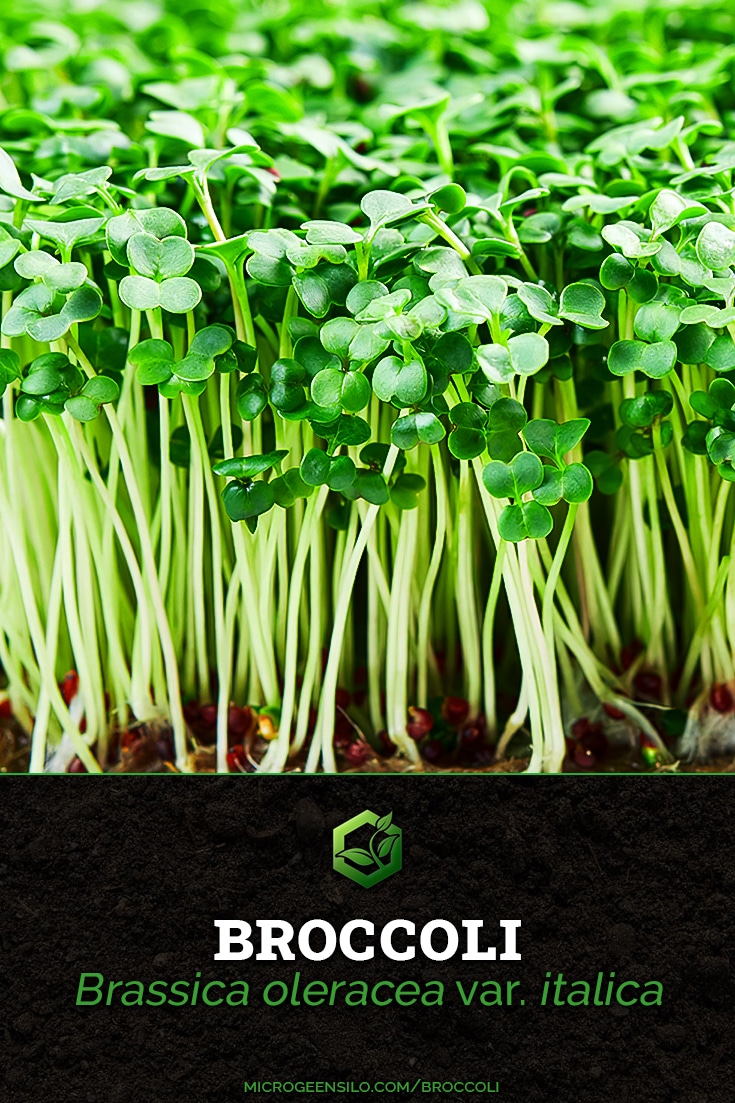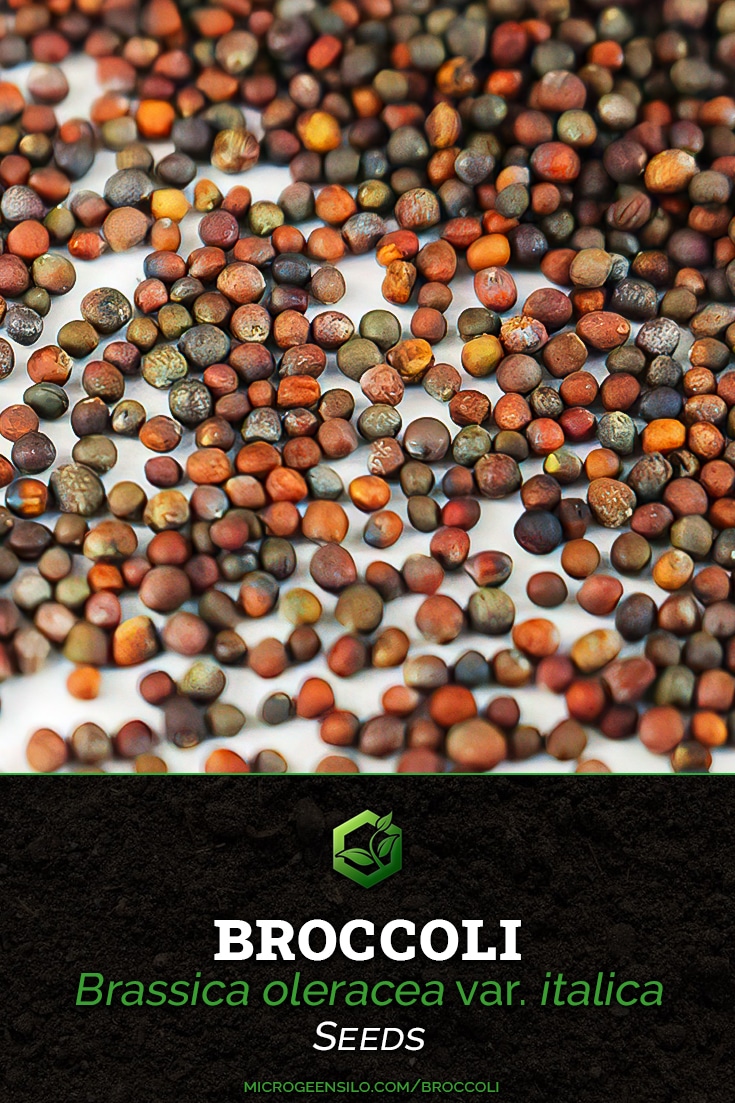Broccoli
Calabrese
Brassica oleracea var. italica L.
Broccoli microgreens are versatile and delicious, with a subtle broccoli flavor and tender texture. They add a nice crunch to salads and sandwiches and make a great garnish with their vibrant green color.
Quick Grow Info:
-
Scientific Name: Brassica oleracea var. italica
-
Flavor: Mild broccoli, Tart, Cabbage flavor
-
Seed Rate: 20g-25g per 10″ x 20″ tray
-
Seeds Per in2: 0.1g-0.125g
-
Pre-Soak: No
-
Weight Duration: 2-3 Days
-
Germination Time: 1-2 Days
-
Blackout Time: 1-2 Days
-
Seed To Harvest: 8-12 Days
-
Growing Difficulty: Easy
Did You Know
Fun Fact
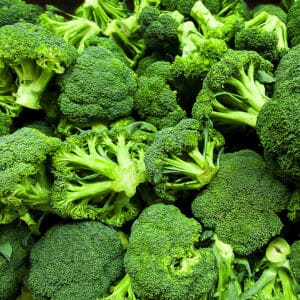
Plant Details &
Grow Guide
Growing Broccoli Microgreens
Want to add a touch of elegance and a burst of mild tart-cabbage flavor? Look no further than Broccoli microgreens! These tiny greens not only add flavor to your meals, but also provide a nutritional boost. In just 8-12 days, you can grow a lush garden of zesty greens that are both a treat for the eyes and a health-boosting delight.
Imagine enriching your dishes with these green beauties. They’re not only visually appealing but also packed with tons of health benefits. Are you ready to start cultivating your broccoli microgreens? Let’s go and get our hands dirty!
Step 1 Preparing Your Broccoli Seeds
First, you need to measure your seeds using a scale. The best seeding rate for a 10″ × 20″ tray is 20-25 grams. If you plan to grow them in a 10″ × 10″ tray then simply divide the total amount by two, in this case, 10-12.5 grams.
If you’re a rebel like me you can just eyeball it without weighing, just make sure that your seeds are approx ⅛-¼” (3-6mm) apart.
After measuring out your broccoli seeds, avoid washing and pre-soaking them. Wet seeds are difficult to spread evenly on your growing medium due to their small size.
Step 2 Sowing Your Seeds
To get started, prepare your growing tray by filling it with your preferred medium such as soil, potting mix, coco coir, or any other medium you prefer. But make sure to leave 1-2cm of empty space between the tray edge and the soil level.
This will help you during the harvesting process by minimizing the chances of accidentally digging into the medium with a knife.
After filling the tray, use your hands to level the medium so that it’s not clumpy. This is important because if the medium is uneven, the seeds may group together when you sow them, which can hinder their growth.
Start by lightly spraying your growing medium with a spray bottle until it becomes slightly damp, but not overly saturated.
Next, carefully distribute the seeds evenly across the surface of the medium. Take your time to ensure that they are spread out in a uniform manner. Finally, give the seeds a gentle misting with water so that they are all covered with a fine layer of moisture.
Step 3 Germination & Weight Period
Take an empty tray without any holes and put it on top of the seeds you have planted. I usually use a 15lb (6.80kg) paving block for trays that are 10″ x 20″ or a 7lb (3.17 kg) brick for trays that are 10″ x 10″.
This assists the seed’s radicle in penetrating the soil when it starts to grow. Without any weight, the radicles find it more challenging to dig into the growing medium and establish firm roots.
Keep in mind that the seeds will germinate while they’re covered and weighed down. A lot of people confuse the germination and weight period to be independent of one another and that you add them together, this is incorrect.
The germination time is there to give you an idea by what time the seeds will germinate, but you don’t add the germination time and blackout period together.
While your seeds are germinating and are weighed down you will need to keep your medium moist. You can do this by lightly misting your seeds every 12 hours, once in the morning and once at night.
Step 4 Blackout Time
After weighing down the seeds for about 2 to 3 days, they should have sprouted and now you can carefully lift the weighted tray. It’s time to remove the weight and begin the blackout phase.
Take your empty tray and flip it over to create a dome that blocks out light. Place it back over your seeds.
By keeping them in darkness for another 1 to 2 days, the newly sprouted seedlings will naturally stretch and reach out for light, helping them grow taller.
Now you can start watering your broccoli microgreens from the bottom. Simply add water to the drainage tray underneath. Personally, I recommend adding 1 cup of water twice a day. Once in the morning and once in the evening (every 12 hours).
Once the blackout period of 1 to 2 days is over, you can remove the top tray or blackout dome and expose your microgreens to light. I’ve found that providing them with 17 hours of light followed by a 7 hour break works well for me.
Continue growing your broccoli microgreens for additional 5 to 9 days, remembering to water them daily with approximately 2 cups of water per day. Once every 12 hours.
Step 5 Harvest
Harvesting your broccoli microgreens is straightforward that only requires a sharp tool. Personally, I absolutely love using the Green Mercer Produce Knife—I highly recommend it! But if you prefer scissors, that’s also completely fine; just make sure they’re sharp!
Now, here’s an important tip to keep your harvest pristine; make sure to keep your chosen tool (whether it’s a knife or scissors) away from the soil! It’s imperative in avoiding any accidental contact between the blade and the soil, you don’t want any unwanted dirt from sneaking into your microgreen harvest and contaminating it.
By following this important pointer, you’ll ensure that your harvested microgreens are of top notch quality and purity.
Plant Details & Taxonomy
Adding nutrient-rich broccoli (Brassica oleracea var. italica L.) microgreens to your diet is quick and easy.
These microgreens have a mild cabbage flavor that makes salads, sandwiches, and other dishes taste gourmet.
They not only add flavor but also enhance the visual appeal of your meals with their beautiful creamy white stems and green leaves, making your overall dining experience more enjoyable.
Whether you’re a seasoned gardener or a beginner looking to add nutritional value to your meals, growing them is a straightforward process.
| Rank | Scientific Name |
| Kingdom | Plantae – Plants |
| Subkingdom | Tracheobionta – Vascular plants |
| Superdivision | Spermatophyta – Seed plants |
| Division | Magnoliophyta – Flowering plants |
| Class | Magnoliopsida – Dicotyledons |
| Subclass | Dilleniidae |
| Order | Capparales |
| Family | Brassicaceae – Mustard family |
| Genus | Brassica L. – mustard |
| Species | Brassica oleracea L. – cabbage |
| Subspecies | Brassica oleracea L. var. italica Plenck – sprouting broccoli |
| Common Names | Broccoli, Calabrese, Sprouting Broccoli |
Microgreen Pests & Diseases
The following are the most common pests and diseases that can affect your microgreens.

White Mold – Sclerotinia sclerotiorum
Sclerotinia sclerotiorum is a necrotrophic fungal disease that causes what’s known as white mold, it can infect over 400 plant species worldwide. It’s also called cottony soft rot, stem rot, watery soft rot, crown rot, and seedling blight.
S. sclerotiorum key properties are its ability to create sclerotia which are its black resting structures, and mycelium which are the white fuzzy spiderweb-like growths you see on stems and growing medium.

Damping Off
Damping-off is an umbrella term that covers fungi and fungi-like organisms in several genera including Rhizoctonia, Botrytis, Phytophthora, and Fusarium, with the soil fungus Pythium being the often culprit.
Damping-off is a soil-borne fungal disease that affects seeds and seedlings typically by rotting of the stems and roots at and below the soil surface.
When a seed germinates the seedling will emerge fine but within 24 hours to a few days will become mushy and water-soaked, collapse at the base of the stem and die.

Aphids – Aphidoidea
Aphids suck! Quite literally. They’re soft-bodied insects that use their piercing-sucking mouths to feed on plants and there are over 4,000 aphid species in the world.
Other common names are greenflies, blackflies, and plant lice. They come in varying colors such as light green, black, white, brown, gray, or yellow.
When aphids feed on plants they secrete a sticky fluid which is called honeydew (no, don’t eat it). This goo they leave behind drips onto plants and can attract other pests such as ants. If the honeydew is left on leaves it can promote black sooty mold.
Broccoli Nutrition Facts
Broccoli microgreens are loaded with nutrients, providing 141 calories per serving.
They offer a balanced energy source with 6.64g carbs and 2.82g protein.
With only 0.37g of fat and no cholesterol, these microgreens are a healthy option.
They’re rich in dietary fiber with 2.6g and are an excellent source of vitamins C, K, and A.
They also contain minerals such as iron, potassium, and calcium, as well as phytonutrients like β-carotene and lutein + zeaxanthin.
Incorporating broccoli microgreens into your diet can be a delicious way to boost your nutritional intake and support overall well-being.
| Principle | Nutrient Value | Unit | RDA |
| Energy | 141 | Kcal | 7% |
| Carbohydrates | 6.64 | g | 5% |
| Protein | 2.82 | g | 5% |
| Total Fat | 0.37 | g | 1% |
| Cholesterol | 0 | mg | 0% |
| Dietary Fiber | 2.6 | g | 7% |
| Vitamins | |||
| Choline | 18.7 | mg | 3% |
| Folate | 63 | mcg | 16% |
| Selenium, Se | 2.5 | mcg | 5% |
| Vitamin A | 31 | mcg | 41% |
| Vitamin B1 (Thiamin) | 0.071 | mg | 6% |
| Vitamin B2 (Riboflavin) | 0.117 | mg | 9% |
| Vitamin B3 (Niacin) | 0.639 | mg | 4% |
| Vitamin B-6 (Pyridoxin) | 0.175 | mg | 13% |
| Vitamin C | 89.2 | mg | 99% |
| Vitamin E | 0.78 | mg | 5% |
| Vitamin K | 102 | mcg | 85% |
| Electrolytes | |||
| Sodium, Na | 33 | mg | 2.20% |
| Potassium, K | 316 | mg | 6.72% |
| Minerals | |||
| Calcium, Ca | 47 | mg | 4.70% |
| Copper, Cu | 0.049 | mg | 5.44% |
| Iron, Fe | 0.73 | mg | 9.13% |
| Magnesium, Mg | 21 | mg | 5.12% |
| Manganese, Mn | 0.21 | mg | 9.13% |
| Phosphorus, P | 66 | mg | 9.43% |
| Potassium, K | 316 | mg | 6.72% |
| Zinc, Zn | 0.41 | mg | 3.73% |
| Phytonutrients | |||
| β-Carotene, beta | 361 | mcg | 9.03% |
| α-Carotene, alpha | 25 | mcg | 4.17% |
| Lutein + zeaxanthin | 1400 | mcg | 23.33% |
Recommended Products
Explore my top curated picks for products needed to grow microgreens. Rest assured that all the featured items and products have been meticulously put to the test by me or have received glowing recommendations from my esteemed readers.
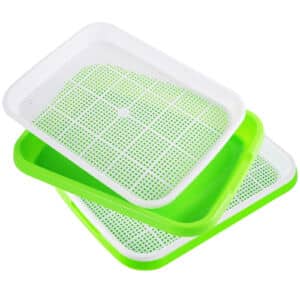
Microgreen Grow Trays
For my personal home use, these microgreen trays are my go to. Measuring around 12.2 x 9.06 x 1.77 inches (31 x 23 x 4.5 cm), these trays are perfectly suited for cultivating microgreens in a home microgreen grow room. What’s more, they’re durable, and cleaning them is a walk in the park, making them an all-around convenient choice.
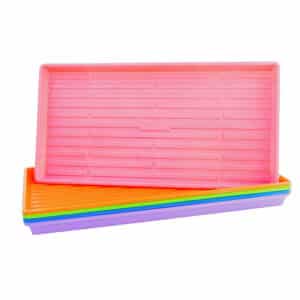
1020 Microgreen Trays – Shallow Extra Strength Colors
Industry leading BootStrap Farmers 1020 microgreen trays! Designed with long lasting durability in mind, these colorful trays are built to withstand years of use and abuse. With a height of 1¼ inches (3.2 cm), these shallow trays make harvests easy, saving you time and increasing your yield. The trays come equipped with 36 drainage holes that effectively remove excess water, promoting a healthy growing environment and preventing mold growth. If you’re serious about growing microgreens and want the best trays available on the market, these trays are it!
